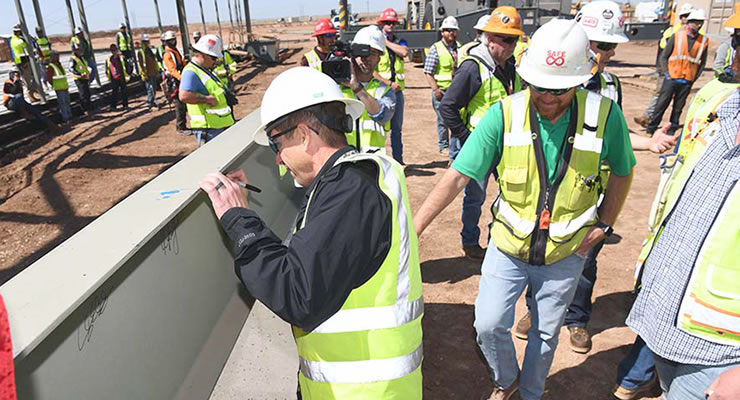
Consolidated Nuclear Security recently completed “topping out” the High Explosives Science and Engineering (HESE) facility at Pantex. Topping out was achieved as the construction crew placed the final steel beam on the Technology Development and Deployment Lab, one of three structures for the 72,762-square-foot complex.
“It is exciting to watch this vital facility take shape,” Pantex Senior Director for Project Management Russell Daniel said. “Our project team, in partnership with the National Nuclear Security Administration (NNSA) and our construction subcontractor Hensel Phelps, has worked extremely hard to reach this milestone.”
A Congressional Line Item project, the HESE will replace 15 obsolete facilities at Pantex, the average age of which is 68 years old, and support the Pantex High Explosive (HE) Center of Excellence for Manufacturing mission for NNSA.
“Congratulations to the HESE construction project team for reaching the significant milestone of placing the final steel beam,” said Monty Cates, Explosive Technology Operations senior director. “The people in Explosives Technology Operations are committed to doing our part for the Pantex’s Global Security Mission. We appreciate all the hard work getting the project to this point, and are greatly encouraged by the progress on a facility that ensures the high explosives mission is sustained for the next generation. It is awesome to see a hopeful vision becoming a tangible reality.”
The HESE facility will provide laboratory space, classified and unclassified office and meeting areas, and a shower and change-out area for HE Operations personnel all in closer proximity to HE manufacturing operations at Pantex.
“This is part of our ongoing efforts to modernize Pantex and provide state-of-the-art amenities for our high explosives scientists and engineers.” said Colby Yeary, Pantex site manager.
“The facility will qualify new HE and assess legacy HE returning from the nuclear weapons stockpile as well as help develop and sustain high-quality scientific staff; support computational and experimental capabilities; and support development of additional evaluation and diagnostic tools.”


Leave a Reply
You must be logged in to post a comment.